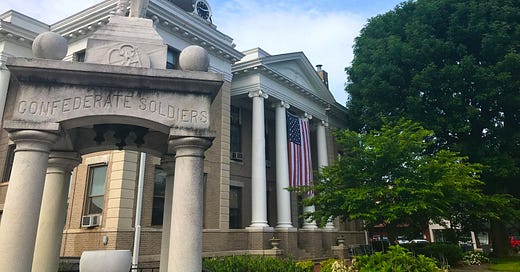Murray, Kentucky doesn’t attract a lot of headlines. It’s a small town in the western Kentucky hill country. It’s sleepy and quiet. We’ve got an outstanding regional university that I flunked out of (twice) before getting my stuff together and getting my Ph.D. years later. It’s pretty in Murray. Lots of green spaces. It’s quiet. It’s quite literally the kind of place that you go to the Walmart when you’re bored to go see if anyone you know is around.
When you’re in high school in Murray, you drive up and down Main Street, making your way past the Dairy Queen before circling back towards the Courthouse Square on a Friday or Saturday night. And then you see it.
Yep. Robert E. Lee. The patron saint of American traitors and a particularly cruel slaveholder to boot. Right there next to our courthouse, his likeness a continuing endorsement of his every ideal.1 Murray is one of two towns in Kentucky where you can find a statue of the man. And it probably won’t surprise you to learn that my little burg votes consistently red every chance it gets.
And while that always frustrated me, I kind of understood why Murray votes the way it does. Kentucky was a lot like other places, fractured over the war. Western Kentucky was solidly Confederate, and as Heather Cox Richardson has shown, the failure to firmly and finally win the narrative war over the war and its causes continues to plague contemporary politics.2 So I get it. I don’t like it, but I get it.
But Murray has changed. It’s gotten mean. Embracing the ideology of MAGA over the last few years, eschewing even the Reagan-era stories about families and decency it at least told itself. But Murray, Kentucky (pop. 18,086) is not going to make or break any federal election. So that means that while the Old South is still in play, we have to look elsewhere to explain the rise of MAGA in America.
I’ve been thinking about this for a while, looking for answers but not knowing where to start. Enter Sasha Abramsky, political journalist and author of Chaos Comes Calling: The Battle Against the Far-Right Takeover of Small Town America. I invited Sasha on the pod and one of the things we talked about was the need to expand our geographic understanding of MAGA’s appeal to small towns in seemingly unlikely places like northern California and Oregon.
And as our conversation continued, we talked about a bunch of other issues that made MAGA so enticing to small towns, such as disdain for big cities, federal and state responses to COVID, and even an antipathy towards higher education.
This was a really fascinating conversation with a guy with a keen understanding of the intellectual underpinnings of many rural Americans. We only scratched the surface of what’s in the book and what Sasha has to offer, including some real rays of hope for the future.
About our guest:
Sasha Abramsky has taught in University Writing Program at UC Davis for 18 years. A freelance journalist, his work has been published in the Nation -- where he is currently the West Coast correspondent and a weekly columnist -- New Yorker online, the Atlantic, the American Prospect, Rolling Stone, Mother Jones, Salon, Slate, the London Guardian, the Observer, the Village Voice, the LA Weekly, Sacramento News & Review, Sacramento Magazine and many other publications. He is the author of nine books, including The American Way of Poverty, listed by the New York Times as among the 100 Notable Books of 2013, the recently published family memoir The House of Twenty Thousand Books, and the biography Little Wonder: the Extraordinary Story of Lottie Dod, the World's First Female Sports Superstar, which was shortlisted for the William Hill Sports Book of the Year prize in 2021.
Find his book
Find it here on Amazon or wherever you find your books.
The pod
Without further ado, find my conversation with Sasha Abramsky on Apple and Spotify below or wherever you listen.
One last thing- we are venturing further and further into some rough waters here with what we are tackling both in my writing and the podcast. If you want to help elevate my voice and make Reckoning a national power, the best way to do so is by upgrading to a paid subscription, which you can do via the button below. There’s a lot more stuff coming your way. Thanks for being here.
If you’d like to read more about Confederate monuments and memory of the Civil War, check out Karen Cox’s No Common Ground. It was recently banned by the Department of Defense, so you know it’s good. You can also see Adam Domby’s The False Cause for how the Lost Cause narrative haunts Americans to this day.
I have every book Heather has authored. And I’ve actually read them, something I can’t say for every item on my shelves. If I have one to recommend during this moment and time, it’s How the South Won the Civil War. It’s more of a thought piece that puts all these things in play and spell them out in a way that will make them make sense.







Great read!
I live in a rural town in Oregon that is led by a MAGA driven mayor and his like-minded councilmen. The children here go to a high school that is rated terribly low in academic testing. A lot of the people living in my town grew up here.
Their High School’s current academic proficiency ratings:
• Math - 15%
• Science - 18%
• Reading - 38%
• Graduations - 74%
I would like to see a study of rural town academic proficiencies compared to their voting percentages. Do those towns with higher educational ratings (scores, not degrees), vote differently?